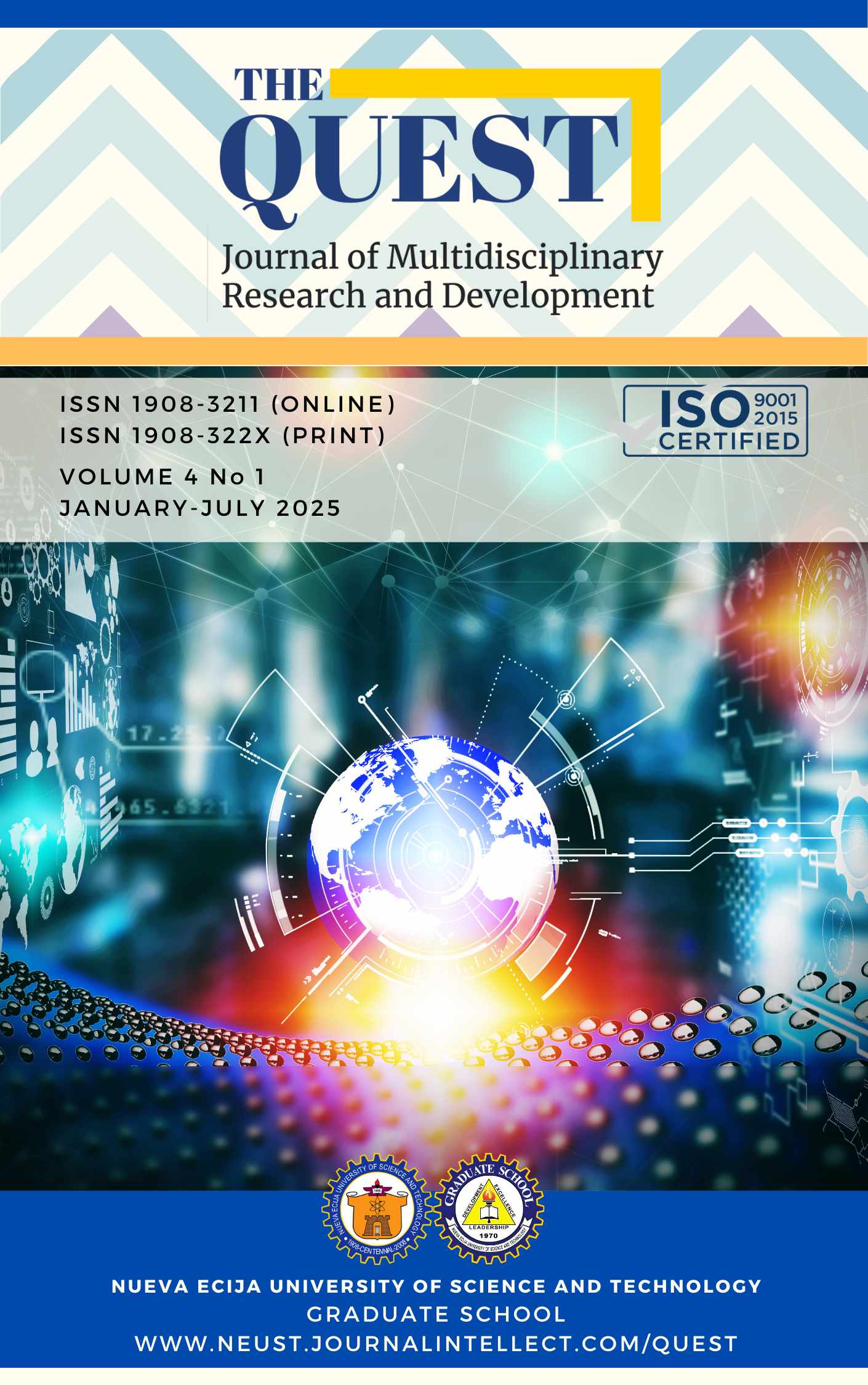Challenges and Issues in Utilization of Emerging Technologies in Undergraduate Research Writing at Holy Cross College, Sta. Rosa, NE., INC.

Published 07/25/2025
Keywords
- Emerging Technologies,
- Undergraduate Research,
- UTAUT Framework,
- Institutional Support,
- Technology Adoption
How to Cite
Copyright (c) 2025 The QUEST: Journal of Multidisciplinary Research and Development

This work is licensed under a Creative Commons Attribution-NonCommercial 4.0 International License.
Abstract
This study examines the use of emerging technologies in undergraduate research at Holy Cross College, Sta. Rosa, N.E., Inc., using the Unified Theory of Acceptance and Use of Technology (UTAUT) as a framework. A mixed-method approach, combining a structured survey and open-ended questions, gathered data from 70 students across various programs. The results show that while emerging technologies enhance research efficiency and quality, barriers such as limited technical skills, insufficient infrastructure, and inadequate training impede widespread adoption. Although students report high-performance expectancy and ease of use, challenges like limited access to necessary software and resources persist. The study concludes that while integrating emerging technologies offers clear benefits, stronger institutional support is needed. The recommendation calls for Holy Cross College to invest in better technological infrastructure and provide comprehensive training to support the adoption and effective use of these tools in undergraduate research.
References
- Ali, A. M., Mohamed, A., Ismail, N., & Aziz, A. (2022). Redesign of Active Learning with Using Digital Tools to Develop Student Soft Skills. Studies in Educational Management (SEM), 12.
- Arpaci, I. (2017). Antecedents and consequences of cloud computing adoption in education to achieve knowledge management. Computers in Human Behavior, 70, 382-390.
- Ayoko, V. O., Peter, T., & Jegede, D. O. (2023). Inadequacy of infrastructural facilities in public universities in Nigeria: Causes, effects and solutions. International Journal on Integrated Education, 6(3), 36.
- Berardinucci, F., Colombo, G., Lorusso, M., Manzini, M., Terkaj, W., & Urgo, M. (2022). A learning workflow based on an integrated digital toolkit to support education in manufacturing system engineering. Journal of Manufacturing Systems, 63, 411-423.
- Blichfeldt, H., & Faullant, R. (2021). Performance effects of digital technology adoption and product & service innovation–A process-industry perspective. Technovation, 105, 102275.
- Callo, E. C., & Yazon, A. (2020). Exploring the factors influencing the readiness of faculty and students on online teaching and learning as an alternative delivery mode for the new normal. Universal Journal of Educational Research, 8(8), 3509-3318.
- Calvert, S., Kennedy, M. L., Lynch, C., & O'Brien, J. (2020). Emerging Technologies for Research and Learning: Interviews with Experts.
- Chen, L., & Aklikokou, A. K. (2020). Determinants of E-government adoption: testing the mediating effects of perceived usefulness and perceived ease of use. International Journal of Public Administration, 43(10), 850-865.
- Daniel, C., & Pettit, C. (2021). Digital disruption and planning–use of data and digital technology by professional planners, and perceptions of change to planning work. Australian Planner, 57(1), 50-64.
- Eakin, J. M., & Gladstone, B. (2020). “Value-adding” analysis: Doing more with qualitative data. International Journal of Qualitative Methods, 19, 1609406920949333.
- Francom, G. M. (2020). Barriers to technology integration: A time-series survey study. Journal of Research on Technology in Education, 52(1), 1-16.
- Gkrimpizi, T., Peristeras, V., & Magnisalis, I. (2023). Classification of barriers to digital transformation in higher education institutions: Systematic literature review. Education Sciences, 13(7), 746.
- Limniou, M. (2021). The effect of digital device usage on student academic performance: A case study. Education Sciences, 11(3), 121.
- LlenadaSantos, J. V. (2022). Comparative analysis of mobile applications for its integration in college mathematics subjects. EDUCATIO: Journal of Education, 6(4), 324-345.
- Lozano-Álvarez, M., Rodríguez-Cano, S., Delgado-Benito, V., & Mercado-Val, E. (2023). A systematic review of literature on emerging technologies and specific learning difficulties. Education Sciences, 13(3), 298.
- Mitha, S. B., & Omarsaib, M. (2024). Emerging technologies and higher education libraries: a bibliometric analysis of the global literature. Library Hi Tech.
- Nassar, A., & Kamal, M. (2021). Ethical dilemmas in AI-powered decision-making: a deep dive into big data-driven ethical considerations. International Journal of Responsible Artificial Intelligence, 11(8), 1-11.
- Perkel, J. M. (2020). Synchronized editing: the future of collaborative writing. Nature, 580(7801), 154-156.
- Rahardja, U. (2022). Blockchain Education: as a Challenge in the Academic Digitalization of Higher Education. IAIC Transactions on Sustainable Digital Innovation (ITSDI), 4(1), 62-69.
- Roni, S. M., & Djajadikerta, H. G. (2021). Data analysis with SPSS for survey-based research. Singapore: Springer.
- Singh, P., & Dhiman, B. (2023). Exploding AI-Generated Deepfakes and Misinformation: A Threat to Global Concern in the 21st Century. Authorea Preprints.
- Yamson, G. C., Appiah, A. B., & Tsegah, M. (2018). Electronic vs. print resources: a survey of perception, usage and preferences among central university undergraduate students. European Scientific Journal, 14(7), 291-304.
